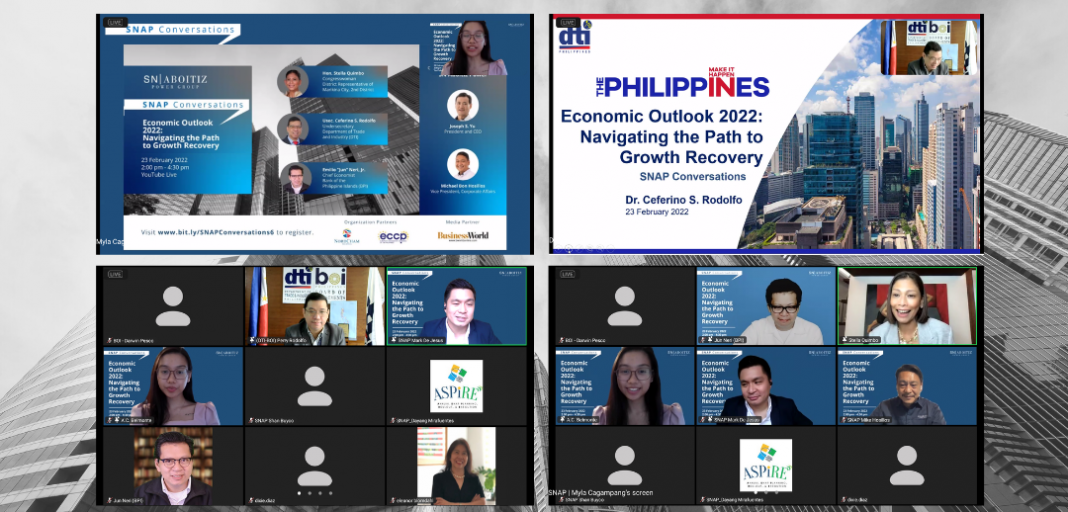Charting the path toward the post-pandemic recovery, the Board of Investments (BOI) discussed the major economic reforms and plans of the Philippine government during the SNAP Conversations webinar held recently (February 23, 2022).
Trade Undersecretary and BOI Managing Head Ceferino Rodolfo pointed out that the Philippine Gross Domestic Product (GDP) growth this year is expected to go up, hovering around seven percent, according to the data provided by the IHS Markit. Such growth in the GDP is beefed up by strengthening domestic demand, the Undersecretary added.
“We are ready to Make it Happen for you in the Philippines,” said the Undersecretary, as the BOI is expecting a better year for the Philippine economy in 202, with the easing of health restrictions and allowing the entry of fully vaccinated foreigners for business or tourism purposes.
According to Undersecretary Rodolfo, some of the major policy reforms are the economic measures to improve the business environment in the Philippines namely: the Corporate Recovery and Tax Incentives for Enterprises (CREATE) Act and the amendments to the Public Service Act (PSA), the Foreign Investments Act (FIA), and the Retail Trade Liberalization Act (RTLA).
Strong economic growth is forecasted over the medium-term economic outlook, buttressed by strong private consumption and government infrastructure investments coupled with accelerated vaccination programs of the Philippine government and reopening of businesses, said the Undersecretary.
As to the Strategic Investment Priorities Plan (SIPP), it is still pending and being finalized. The Undersecretary listed down the criteria for the transitional SIPP tiers: for Tier I are preferred activities, export-oriented, and special laws, which are already under the IPP 2020 – serving as the interim SIPP to make sure that there is no gap in terms of investments coming into the country. Under Tier 2 are activities that fill in gaps in the Philippine Industrial value chains for a competitive and resilient economy while Tier 3 promotes innovation critical to structural transformation.
The BOI, the leader of the country’s Investment Promotion Agencies (IPAs), strives for a modern and post-pandemic Philippine economy. As such, Tier III of the transitional SIPP specifically covers adopting advanced digital production technologies of the fourth industrial revolution such as robotics, AI, additive manufacturing, data analytics, and the like.
As the world is shifting toward a green economy and supply chain, the Philippines emphasized the need for the processing of critical elements for green technology such as nickel, copper, and cobalt, which all are abundant in the country. With the processing of such minerals, it will be advantageous to the Philippines, for the world is now focusing on renewable energy, leveling the playing field for alternative sources of energy.
On the other hand, Undersecretary Rodolfo hopes that the Senate will finally ratify the Regional Comprehensive Economic Partnership (RCEP). “We are still hopeful we could still have the window for having the RCEP ratified,” he said.
On the geopolitical movements in the world, aside from the pandemic, the BOI is monitoring the developments in the Russia and Ukraine crisis. Despite its possible economic fallout to many countries, including the Philippines, the conflict could still entail upsides for the Philippines, as it may push investors from Central and Eastern Europe to look for another market to do business as part of their relocation and diversification. Further, the Undersecretary cited the surge of food and fuel prices and supply disruption as the two major possible ramifications of the said crisis.
On the impact on businesses and emergency industry trends, Mr. Emilio “Jun” Neri, Jr., the Chief Economist of the Bank of the Philippine Islands (BPI), said that 2022 has a positive outlook for the Philippine economy, as the students will likely boost consumption and mobility return to pre-pandemic level.
But inflation will remain a challenge this year at 3.8 percent, based on the BPI official economic projection. Some downside risks that could affect the projected 7 percent GDP growth in the country are the following: energy supply and elevated prices, Eastern Europe tensions, employment and inequality, elections conduct and outcome, external market volatility, and emerging COVID variants.
For her part, Rep. Stella Quimbo of the 2nd District of Marikina City laid out the ways for the country’s economy to recover: increase government spending, more support for the micro-, small-, and medium-sized enterprises (MSMEs), job creation, digital transformation, and improving economic resilience to withstand future “shocks.”
The Congresswoman emphasized the role of the amendments to the PSA, FIA, the RTLA in improving competition and market performance, generating more jobs for the Filipinos. She added that the Philippine economy can only be resilient if the government sorts out the dearth of social protection for workers and support for business innovation. Other problems that the government should look at are the lack of equipment for teachers and students for online classes, poor financial inclusion, poor digital connectivity, and inadequate protection against floods.
Moreover, the SNAP Conversations was organized by the SN Aboitiz Power Group, one of the leading renewable energy companies in the Philippines. Mr. Joseph Yu, its President and Chief Executive Officer, said that the pandemic created socioeconomic issues and opportunities as well that the country should take advantage of through the partnership and collaborative efforts between the government and the private sector. With the theme “Economic Outlook 2022: Navigating the Path to Growth Recovery,” the said online event provided a snapshot of economic forecasts, emerging industry trends, and growth recovery plans amid the COVID-19 pandemic














